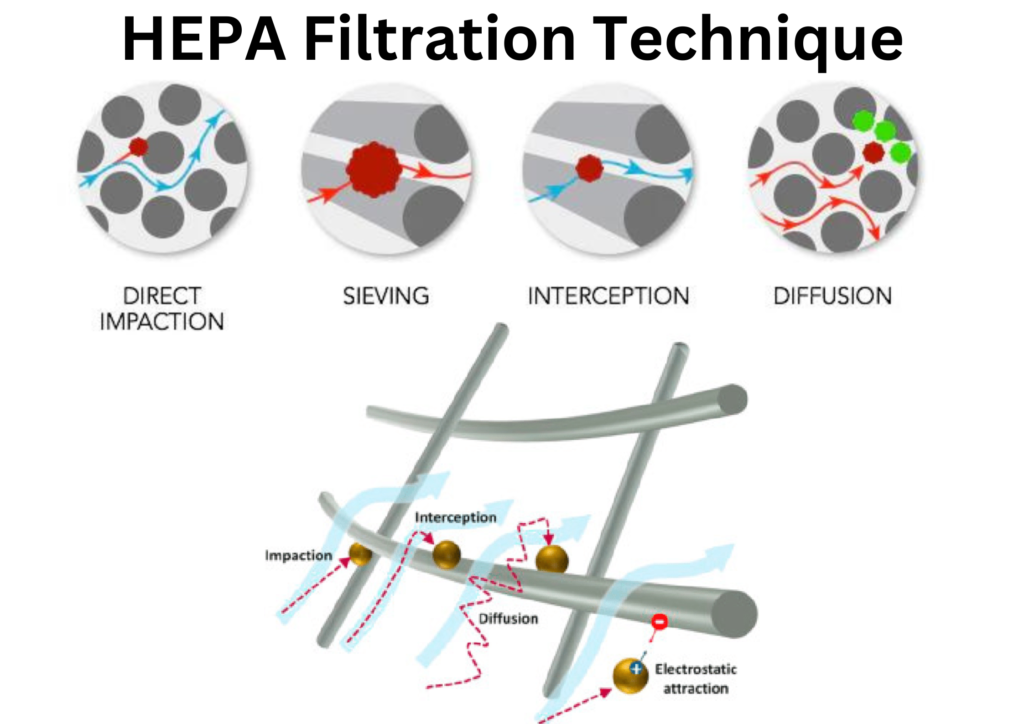During the COVID-19 pandemic, air purifiers with HEPA filtration technology were preferred the most by schools, offices, hospitals, etc. These air purifiers trap the contaminants, viruses, and bacteria from the air and improve air quality. It supplies fresh, clean, and healthy air to the environment. It also prevents the transmission of airborne viruses from one person to another and creates a healthy atmosphere inside a home.
In this article, a clear idea about the HEPA air purifier is represented. The types of HEPA filters, their uses, and how this filtration technique helps in removing various types of pollutants from the air are also discussed.
Definition:
What Is a HEPA Filter?
HEPA filter stands for High-Efficiency Particulate Air filter. This filtration technique traps smaller-sized particles such as dust mites, pollens, pet dander, smoke, etc. from the air. It can remove 99.97% of airborne particles of up to 0.3 microns in diameter by forcing the air through the fine mesh. HEPA filter more efficiently removes particles that are greater than 0.3 microns but, it can not completely eliminate VOCs, ozone, and fine particles.
One micron is one millionth of a meter and we cannot see these particles with our naked eye. 0.3 microns size is considered the “Most Penetrating Particle Size”. This filtration technique is usually implemented in air purifiers and vacuum cleaners.
Materials like synthetic fibers and glass are used to make HEPA filters. Synthetic and glass fibers are tightly packed and interwoven to filter out unwanted particles from the air.
Types of HEPA Air Purifier
There are 3 main categories of HEPA-certified filters.
HEPA Like Filters
Don’t be fooled, if you are in the market to purchase a HEPA air purifier and the shopkeeper is talking about some “HEPA Like” or, “99% HEPA” type air purifier. There are no such designations like this. In clear words, either the air purifier is HEPA certified or it is not. It is totally misleading marketing jargon.
These filters might be a good choice for less vulnerable populations. However, always prefer to buy a certified HEPA air purifier.
True HEPA Filters
Air purifiers with true HEPA filters are of standard and certified types. These air purifiers are tested in scientific labs and meet the HEPA standards for filtration. These filters are capable of removing 99.97% of contaminants of up to 0.3 microns from the air.
H13-H14 Medical-Grade Filters
H13 and H14 grade filters are considered the highest classes of HEPA filters. These filters are also known as medical-grade quality filters.
H13 medical-grade filters are usually implemented in hospitals. The efficiency of these H13-grade filters is higher than the true HEPA filters. They can remove 99.95% of contaminants from the air of size up to 0.1 microns. This advanced filtration technology is suitable for hospitals with highly vulnerable patient populations. It removes allergens from the air that triggers asthma and allergic symptoms.
The H14 grade filters are capable of removing 99.995% of particles from the air of 0.1 microns in diameter. The 0.2-micron size particles are the most difficult to capture. So they are also called the most penetrating particle size.
Efficiency of HEPA Air Purifier
MERV Ratings:
A filter’s ability to remove contaminants from the air is measured by using MERV (Minimum Efficiency Reporting Value) ratings. MERV is a standardized rating system to measure a filter’s performance. MERV scale ranges from 1 to 20. If a filter’s MERV rating is higher, the air purifier is highly efficient.
MERV Rating of HEPA Filter
The MERV ratings of HEPA filters generally fall between 17 to 20 which indicates that the HEPA filter is highly efficient. Its efficiency in removing particles from the air is 99.97%. This filtration technology can trap particles as small as 0.3 microns.
HEPA 13 and HEPA 14 Filters:
The efficiency of the HEPA 13 filter in capturing contaminants from the air is 99.95%. It can trap particles of up to 0.3 microns in size. Whereas, the HEPA 14 filter’s efficiency in removing the same particle size from the air is 99.995%.
The HEPA 14 filters are usually used in research laboratories, hospitals, and pharmaceutical labs, with higher air quality demand. This filter traps contaminants from the air and prevents the transmission of harmful particles inside a closed space.

Working Principle of HEPA Air Purifier
The HEPA filters belong to the mechanical filters category. These are pleated air filters and have a considerable thickness to trap the smallest as well as the largest particulate contaminants. The pleats consist of a random and dense arrangement of fibers to catch a range of particle sizes.
The HEPA air purifier usually draws in polluted air from the side or rear of the air purifier and it circulates purified and fresh air at the top of the device. This ensures good air circulation inside the room.
The HEPA filtration technique uses 4 mechanisms to trap the particles from the air.
- Impaction
- Interception
- Diffusion
- Sieving
Impaction:
In this stage, the particles are trapped by using the principle of inertia. The large and heavy particles are suspended in the airflow stream. As the viscous fluid (air) surrounding these particles is lighter, it enters the fiber space easily by changing its direction. Whereas, the particles move in a straight line and are trapped by the media fibers.
Interception:
In the interception mechanism the medium range size particles that move along with the air flow stick to a fiber. These particles are not large enough to have inertia and are not very small enough to diffuse within the air flow stream. When these particles touch a fiber they are intercepted.
Diffusion:
When the gas molecules smaller than 0.1 microns in size collide with each other diffusion occurs. This process occurs when the particles are the smallest. These particles diffuse within the flow stream and are more likely to traverse in the flow stream. In the next phase, when these particles stick to the fiber, they can be trapped.
Sieving:
Sieving occurs when the particles are too large and cannot be fitted into fiber spaces.
Uses of HEPA Filters
Clean Rooms:
Clean rooms are constructed and designed to create an ideal environment with predefined working conditions. These rooms are sealed and cleansed in such a way that the minute elements are trapped, and removed instantly.
HEPA air purifiers are placed in the ceilings, walls, and cabinets of these rooms to ensure clean and purified air inside them.
In Hospitals:
HEPA air purifiers are installed in hospitals to prevent cross-contamination and spreading of harmful viruses and bacteria. It protects both patients and hospital personnel from airborne diseases. HEPA filtration technology is used in surgical suites, and warming beds to keep the surrounding air of the room clean and free from airborne contaminants and dangerous viruses.
HEPA air purifiers are also used in incubators to protect newborns from bacteria, viruses, and infectious materials in the air. This filtration technology is necessary for use in intensive care units to protect patients with low immunity systems from harmful viruses and contaminants.
Pharmaceutical Industry:
The Food and Drug Administration (FDA) gives high importance to quality assurance in the pharmaceutical industry. For this, they recommend using HEPA filtration technology with H13 and H14 grades in the drug production units.
Removes COVID-19 Virus
According to the Environmental Protection Agency (EPA), air purifiers with HEPA filtration technology are also capable of removing the COVID-19 virus along with other harmful contaminants from the air.
Warehouses:
If the items are stored in warehouses for a longer period of time there are chances of developing harmful airborne particles in the air. To remove those harmful particles from the air HEPA air purifiers are installed in warehouses that remove harmful contaminants from the air and keep the air clean and fresh.
Conclusion
The HEPA filtration technology is the most important part of an air purifier. This is the filtration technology that removes pollutants, dust mites, pollen, and pet dander from the air. Always buy an air purifier with a true HEPA filter. Don’t be fooled by purchasing HEPA-like filters.
The MERV ratings of HEPA filters generally fall between 17 to 20 and its efficiency in removing particles from the air is 99.97%. This filtration technology can trap particles as small as 0.3 microns.
HEPA air purifiers are generally used in hospitals, research labs, pharmaceutical industries, warehouses, etc. It keeps you protected from various harmful diseases, airborne viruses, bacteria, etc.
FAQS
- Are HEPA air purifiers safe?
Yes, HEPA air purifiers are safe. They release very less fiberglass particles into the air and the effect of these particles on the human body is negligible.
2. Is there anything better than a HEPA filter?
ULPA (Ultra Low Particulate Air) filters are better than HEPA filters. The efficiency of ULPA filters in removing smaller particles from the air is 99.99%. It can trap particles of 0.12 microns in diameter or, larger. Whereas HEPA filters remove 99.97% of particles from the air and this filtration technology can trap particles as small as 0.3 microns.
Also Read
- Whole House Air Purifier: Types, Pros, Cons, Working Principle 2024
- Air Purifier Advantages and Disadvantages
- How Do Air Purifiers Help? 6 Benefits
- Whole House Dehumidifier: Types, Working Principle, Pros, Cons 2024
- How Does a Commercial Dehumidifier Work? 2024
- How Does a Dehumidifier Work? Types, Uses, Benefits 2024
- 10 Tips for Buying a Dehumidifier
- Dehumidifier Vs Air Purifier 2024
- Dehumidifier vs. Air Conditioner 2024
- Cool Mist Humidifier: Types, Uses, Benefits, Working Principle 2024
- Do Humidifiers Help with Air Quality? 2024
- When Do You Need a Humidifier? 8 Common Signs
- How Do Humidifiers Work? A Complete Guide 2024
- How Humidifier Helps Breathing? 2024
- Humidifier Vs Dehumidifier Vs Air Purifier: Which One Should You Buy? 2024

20 thoughts on “HEPA Air Purifier: Definition, Types, Uses, Efficiency, Working Principle”